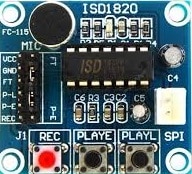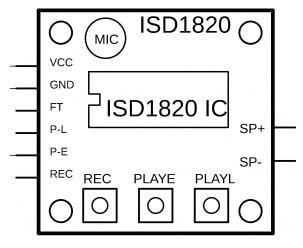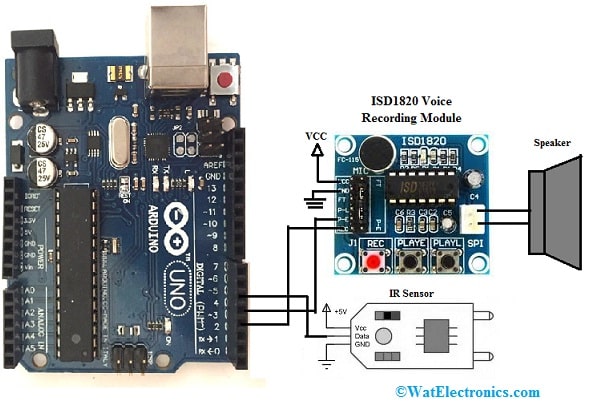SA voice recording module is an electronic device that records & playback audio. So some modules include a microphone & speaker which records multiple messages up to 20 seconds. This module reproduces natural and high-quality audio and voice from the recorded audio through a Mic. The voice recording module capacity mainly depends on its model which ranges from 8 seconds to 64 seconds (or) 1 GB. There are different types of voice recording modules available in the market from other manufacturers like ISD1820, ISD1760, DFR0699, Olympus WS-882, Sony ICD-PX470, Sony ICD-UX570, Tascam Portacapture X8, etc. This article elaborates on the ISD1820 voice recording module, pinout, features, specifications, interfacing and applications.
What is the ISD1820 Voice Recording Module?
ISD1820 is a voice recording module or multiple‐message record or playback device that provides true single‐chip voice recording, non-volatile storage & playback ability for approximately 10 seconds. So this module is easily used by controlling playback, recording, and repeating it with a push button on board (or) with a microcontroller like STM32, Arduino, ChipKi, and many more.
ISD1820 is a small voice recorder and playback module that can perform multi-segment recording so that the user achieves a high-quality recording of nearly 8 seconds to 20 seconds for every application by on-board resistor adjustment. So this module is built with embedded flash memory to hold data for up to 100 years and also easily record or erase the life cycle of up to thousands of years.
ISD1820 module reproduces natural voice and high-quality audio from the audio recorded by a Mic (or) driven through any microcontroller. This module operates in dual operation mode so that it can be used easily according to the requirement. So we can get flexibility in the sampling frequency of the duration and quality of recording by a slight modification of the onboard resistor.

ISD1820 Voice Recording Module
How ISD1820 Voice Recording Module Work?
ISD1820 voice recording module works with 3.3Volts to 5V DC and it has a 3.7V onboard Li-ion battery. So this voice recording module includes two significant push buttons and an LED where these buttons are used for recording & playback of sound and it can be indicated with an LED.
This voice recording module includes an in-built microphone as well as a speaker. So it can be controlled with a microcontroller. Whenever this module gets power the LED will flash once and by pushing the record button on the module, it will start recording. Thus, for every second the LED will blink to show that the recording is in progress. Again pushing the record button will stop recording, and pushing the play button, it play the recorded audio.
ISD1820 voice recording module can easily store up to 60 seconds of audio within non-volatile memory, thus it will not vanish whenever power is not available. So this module is mainly used for recording any audio, messages, or stored music. It is an economic solution and a great method to record & playback audio.
Modes of Operation
This module works in two modes to play the voice within the voice chip playback, edge-activated, and playback, level-activated.
The module in playback, edge-activated mode detects the HIGH signal, after that, the device begins the playback cycle. So this cycle will continue until an EOM (End-of-Message) marker is encountered (or) the memory space end is reached. Once the playback cycle completion is done, then the device powers down itself automatically & into the standby mode.
The module in playback, level-activated detects the signal from L to H. After that, a playback cycle will be started. So Playback continues until the PLAYL pin is pulled LOW (or) an EOM (End-of-Message) marker can be noticed, or the memory space end is reached. So the device will power down automatically to standby mode once the playback cycle completes.
ISD1820 Pin Configuration:
The pin configuration of the ISD1820 module is shown below. This module includes different pins which are discussed below.

ISD1820 Pin Configuration
- Pin (VCC): It is a voltage supply pin that provides a 3.3V to 5V supply.
- Pin (GND): It is the Ground pin of the module.
- Pin (REC): It is a record pin that records any voice.
- Pin (PLAY): It is a playback pin that playbacks audio.
- Pin (LED): It is an LED indicator of the module.
- Pin (IN1): It is an input pin where a microphone is connected.
- Pin (OUT1): It is an output pin where the speaker is connected to this pin.
- Pin (PLAYE): It is a playback edge‐activated pin.
- Pin (PLAYL): It is a playback level‐activated pin
- Pin (Speaker Outputs): The SP+ SP‐ pins are speaker output pins that drive an 8Ω loudspeaker.
- Pin (MIC): It is a microphone input pin of the module.
- Pin (FT or Feed Through): When the mini jumper is connected then this mode allows the Microphone to drive the connected speaker directly. So it will change the module into an existing mic.
- Pin (P‐E): When the mini jumper is connected then it plays the records continually.
Features & Specifications:
The features and specifications of the ISD1820 voice recording module include the following.
- ISD1820 is a voice recording module.
- Its operating voltage ranges from 2.4Volts to 5.5Volts DC
- This module has an internal audio amplifier that drives 8 Ohm 0.5Watts speakers directly.
- It has an on-board microphone.
- This module operates in dual modes standalone and microcontroller-driven.
- It has a push‐button interface and playback is edged or level-triggered.
- It records up to 20 seconds of audio.
- This module has an automatic power-down mode or standby mode.
- Its size L*W*H is 43mm x 34mm x 11mm.
Equivalent & Alternatives
ISD1820-based voice recorder module equivalent is ISD1760. Alternative voice recorder modules include; ISD1820, DFR0699, Sony ICD-UX570, Olympus WS-882, Sony ICD-PX470, and Tascam Portacapture X8.
ISD1820 Voice Recorder Module Interfacing with Arduino
The ISD1820 voice recorder module interfacing with the Arduino board is shown below. In this interfacing, the ISD1820 module has a button that directly records and playbacks sound. Generally, the voice recorder module captures audio or speech in different situations like lectures, meetings, interviews, broadcasts, conferences, etc. so that you can simply edit (or) play them back. The most commonly used voice recorder used in this interfacing is the ISD 1820 voice recorder module which shows how to control it using an Arduino board.
The ISD1820 voice recorder module stores the messages in its non-volatile memory from 8 Sec to 20 Sec lengths. It can also have an audio amplifier internally that drives directly a 0.5W 8Ω Speaker without using any external amplifier circuit. The ISD1820 voice recorder module independently works but the record and playback function controlling using a microcontroller gives you a chance to increase the module functionality to a complex application stage.
ISD1820 Voice Recorder Module Operation:
A small 8Ω Speaker is connected across SP+ & SP-pins at the o/p of the voice module.
Push the REC (record button) on the voice module which starts voice recording. Thus, push this button until you record the message completely.
Here either PLAYL or PLAYE pins can be used to playback. When the PLAYE button is pushed one time then the entire message will be played back.
The PLAYL button needs to be pushed and held then the message begins playing. Thus this button must be released if you want to discontinue the playback.
If you trigger the PE Jumper, then playback will be within endless loop mode.
The required components to make this interfacing mainly include; ISD1820, voice recorder module, Arduino UNO, IR sensor, 8Ω Speaker, breadboard, power supply, and connecting wires. The connections of this interfacing follow as;

ISD1820 Voice Recorder Module Interfacing with Arduino
- The ISD1820 module’s SP+ & SP- pins are connected to the speaker’s terminals.
- The VCC & GND pins of this module are connected to Arduino’s +5V & GND pins.
- The REC & PLAYE pins of the voice recording module are connected to Arduino’s Digital I/O Pins 2 & 3.
- Here, a reflective-type IR Sensor is used where its digital output is connected to Arduino’s Pin-4.
Code
The required code for the ISD1820 voice recorder module interfacing with Arduino is shown below.
int rec=2; int play=3;
int sensor=4; int led=13;
void setup()
{
pinMode(rec,OUTPUT);
pinMode(play,OUTPUT);
pinMode(led,OUTPUT);
pinMode(sensor,INPUT);
digitalWrite(rec,LOW);
digitalWrite(play,LOW);
digitalWrite(led,LOW);
if(digitalRead(sensor))
{
while(digitalRead(sensor));
}
}
void loop()
{
if(digitalRead(sensor))
{
digitalWrite(led,HIGH);
digitalWrite(rec,HIGH);
delay(5000);
digitalWrite(led,LOW);
digitalWrite(rec,LOW);
delay(1000);
digitalWrite(play,HIGH);
delay(6000);
digitalWrite(play,LOW);
while(digitalRead(sensor));
}
}
Working
Once the connections are made as per the above interfacing diagram, need to provide a power supply to the circuit. Whenever there is no object ahead of the IR Sensor then its output will be LOW & Arduino does nothing. Once there is any object ahead of the infrared sensor, then its output will become HIGH & Arduino starts recording a message with the REC Pin by making it HIGH for five Seconds.
The LED throughout this time is connected to Pin-13 can be lit up which indicates that the voice recording module is recording a message. Once the message is recorded, then it will be played back with the PLAYE pin by making it HIGH for six seconds.
This interfacing is used in different small-scale applications like accident voice recordings, security systems, message recording during collisions, etc.
Advantages & Disadvantages
The advantages of the ISD1820 voice recording module include the following.
- This voice module records natural voice, high-quality, etc.
- The embedded flash memory of this module can store up to 100 years of data, even when it is not powered.
- This module can be easily operated with a microcontroller or push buttons.
- This module records in multi-segment mode.
- The sampling frequency of this module can be adjusted by modifying the on-board resistor.
- Its header pins simply allow a microcontroller for easy interfacing.
- This module includes an automatic power-down mode.
The disadvantages of the ISD1820 voice recording module include the following.
- This module’s audio length is limited which records audio only for up to 10 seconds.
- It has a low-watt speaker.
- It may be hard to record while playing an audio file.
- This module needs 3.3V DC to work when this voltage exceeds the module can be damaged.
- An external resistor is necessary for changing the record duration.
Applications
The applications of the ISD1820 voice recording module include the following.
- The ISD1820 voice recording module is designed to record and playback audio messages.
- This module is used in security systems, embedded system projects, and automobiles mainly for playback of voice notes, etc.
- It is used for accident voice recordings, and message recording during collisions.
- ISD1820 voice recording module is used in audio players, toy voices, robot voices, navigation voices, sound effects generators, musical instruments, IVR systems, etc.
Please refer to this link for the ISD1820 voice recording module datasheet.
Thus, this is an overview of the ISD1820 voice recording module which includes pinout, features, specifications, interfacing, procs, cons and its uses. It is a small device that records and plays audio voice. This module includes a microphone which can be controlled through push buttons (or) a microcontroller. This module’s dual operation mode permits it to be utilized in any standalone (or) microcontroller-driven modes. Here is a question for you, what is the DFR0699 module?